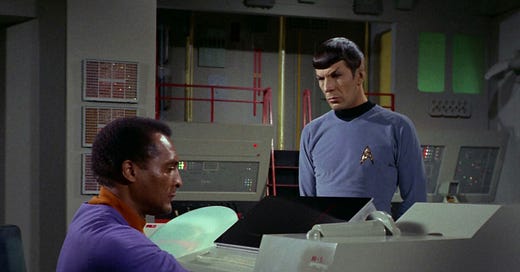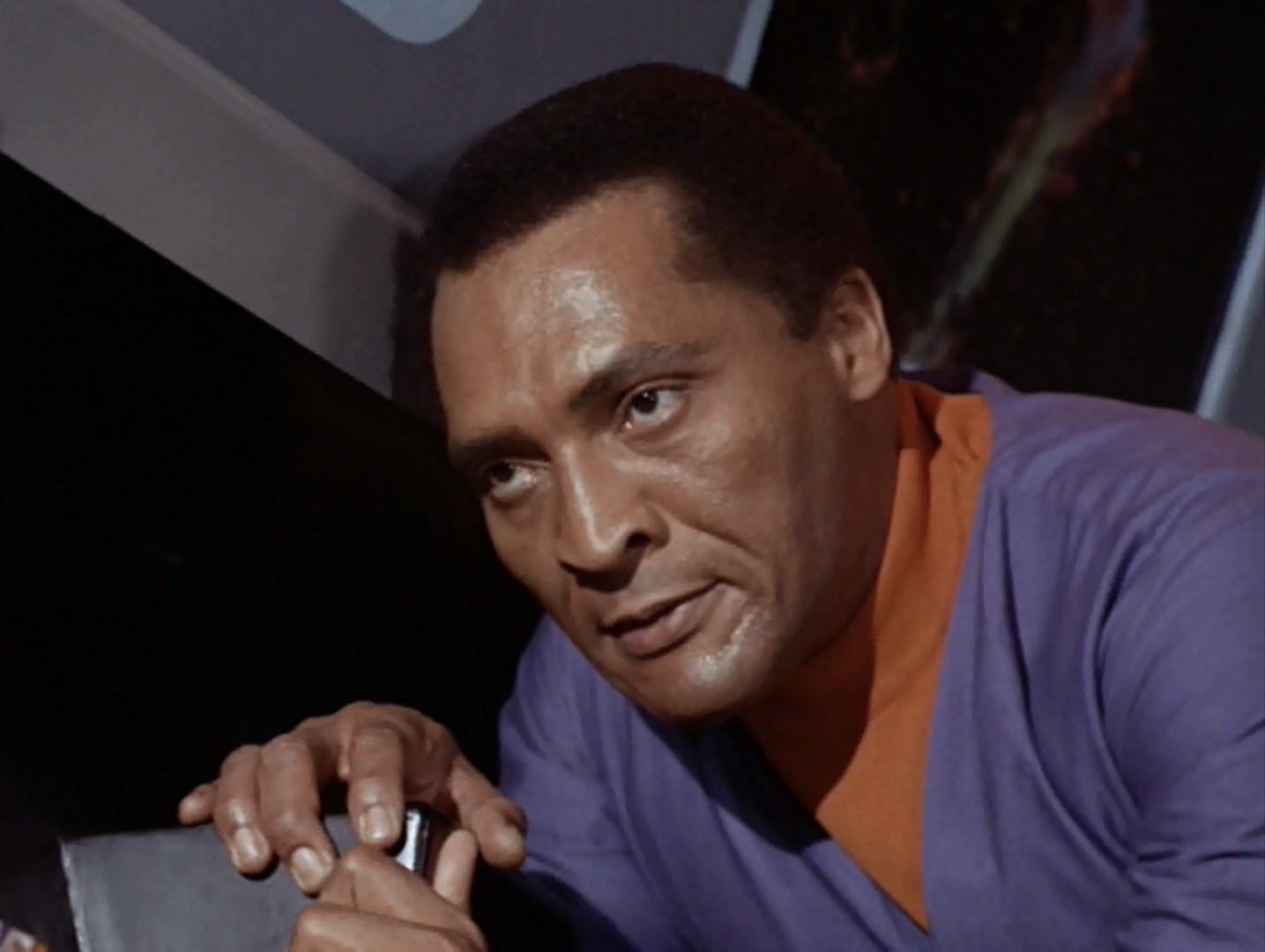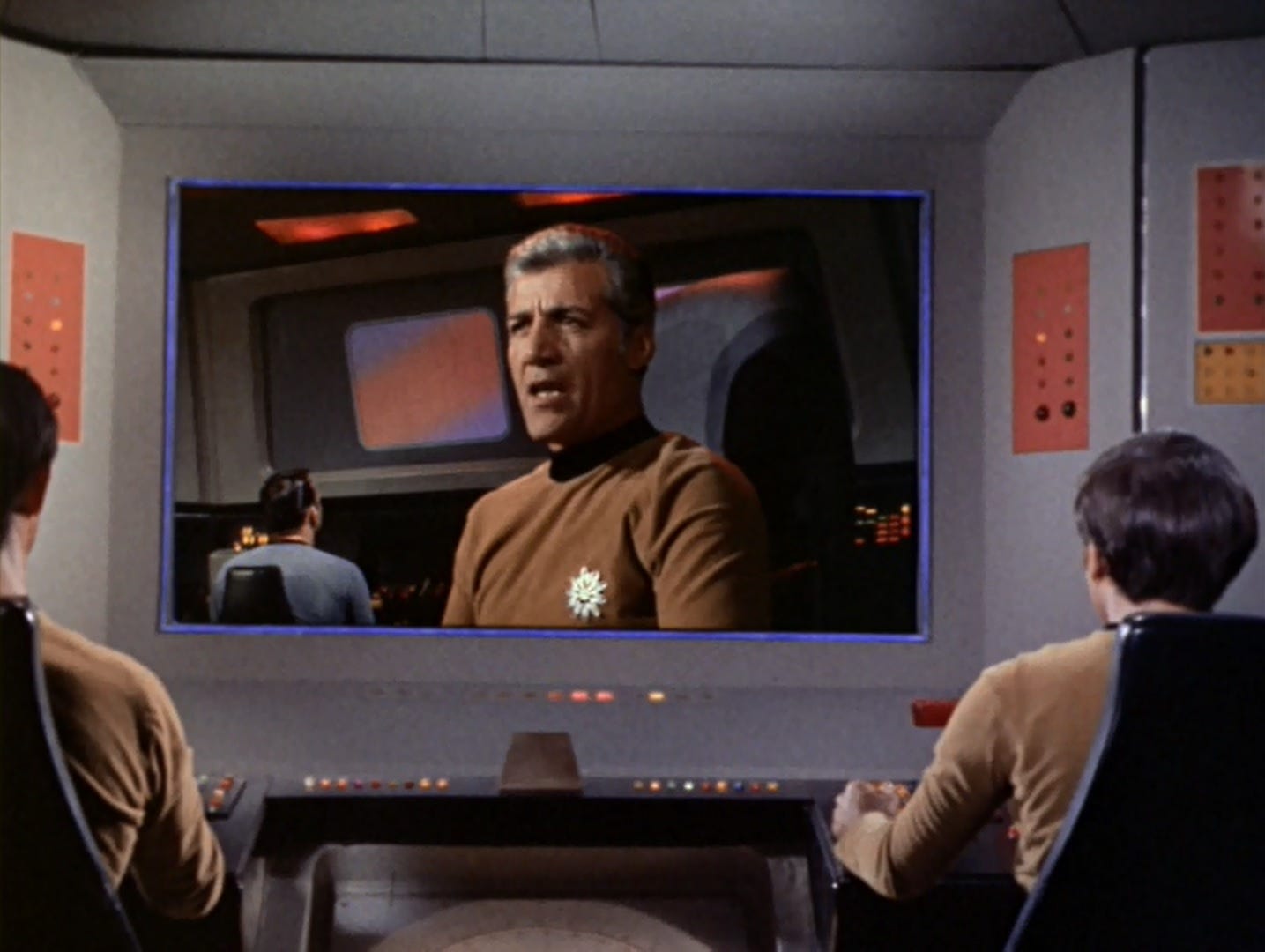"The Ultimate Computer" - Season 2, Episode 24
Star Trek returns to a familiar formula for its best results yet.
All powerful beings, planets based on different historical periods of Earth, literary English canon classics, and thinly veiled Cold war allegories. These are the gristle themes for the Star Trek mill. The show often defaults into these conflicts; their malleability and the audience’s familiarity with the ideas means that they’re suited to a story that can only be 50 minutes longs. A television audience in the late 60s would be aware of the dangers of absolute power, the broad strokes of Shakespeare, present day politics, and the aesthetic signifiers of different eras. The writers trust the audience on these topics and thus often play around with the particulars. The set-up takes care of itself so the real writing to begin.
One would be tempted to add “artificial intelligence” to that list, although Star Trek’s treatment of the concept is neither the dominant science-fiction portrayal of “persons sans bodies” nor the overhyped marketing of predictive text models we see in life today. Computers in Star Trek are like Spock without the heart. They are cold, logical, “perfect” machines; concerned only with inputs and outputs. They are given to misguided interpretations and amorally efficient calculus. An “intelligent” computer in Star Trek will follow an unbreakable logic chain to whatever end is set for it until some flaw or imperfection in that chain becomes untenable. Inevitable contradictions arise and become fatal once Captain Kirk points them out. “The Ultimate Computer” follows the same path as “The Changeling” and “Return of the Archons.” It’s a story Star Trek has told before. The audiences’ relative unfamiliarity with computers likely demanded this formula. Without home computers of any kind, and only a recent integration into some aspects of the economy, the “classical machine” heuristic was both truer and more familiar than a more plastic, thinking conception.
The M-5 Ultimate Computer, pulling duty as the faceless antagonist.
Thus, Star Trek has done the “The Ultimate Computer.” But not this well! The episode may be derivative in structure, but it is well-directed, well-paced, funny, insightful, and armed with one of the best guest performances of its run. It is everything you can ask for from procedural television.
Presciently, automation takes center stage at the start of the episode, an anxiety that has remained with us until the present day and only become more relevant. “Does the Enterprise need a Captain?” is the central question here. Called into a Starbase by command, Kirk and the crew find out that they’ve been conscripted into an in-field test of a new starship computer system: the M-5. The brainchild of Dr. Richard Daystrom - a now-aged child prodigy responsible for the earliest starship computer systems - the M-5 is meant to automate large chunks of the ship’s operations. After installation, the Enterprise needs only a skeleton crew to travel, fight, and explore. The Federation hopes to test out some war games and simulations to determine if the M-5 is ready for prime time. Dr. Daystrom comes aboard to monitor.
Dr. Daystrom (William Marshall) desperately pleads with his creation, the eponymous M-5 ultimate computer. Marshall gives one of the best guest performances in the show, at first displaying a confident ease that slips into insecure mania by the end. His deep voice, startling height, and expressive eyes lend him an impressive gravitas that the script undermines as the stakes get raised. It’s worth noting that Marshall - perhaps best known for the title role in the Blacula (1972) horror spoof series - is one of the only Black guest stars so far. Daystrom’s blackness is not an explicit focus of the episode, but it is not hard to see how the character’s striving, self-conscious genius is given some extra texture by his race.
The script, credited to the always reliable D.C. Fontana, paces out the story perfectly. Daystrom is introduced via Spock’s respect for him, he is trustable, confident, and impressive. In the first half of the episode, things go largely according to plan. The M-5 demonstrates acumen and allows for some meta-commentary on the nature of the show. Captain Kirk and McCoy are simply “unnecessary” to most missions and are left off the M-5’s scout team of an uncharted world. The show understands that sending the most important person on the ship on dangerous ground deployments in every episode is nonsensical, but it also understands that that’s good television. The first half of “The Ultimate Computer” shows that the most sensible way of executing an episode of Star Trek is also the most boring. Teams assigned via skill and without regard to how the audience may feel about the characters included, decisions reached via careful and cold analysis rather than impassioned argument, Daystrom’s ultimate thinking machine a danger to the drama, not the crew. As Kirk says, “I’ve never felt this way before, at odds with the ship.” Kirk loves the ship - an idea Season One had a predilection for - and it’s that love and touch that make the show a joy. The M-5 goes about its business well in the first half - fixing every problem, making good points, Daystrom somewhat frustratingly vindicated - and Kirk’s insecurity feels earned. This mini-arc climaxes with the M-5’s perfect guidance through a fake battle, after which Starfleet Commodore Wesley jokes that Kirk has become “Captain Dunsel,” with “dunsel” a Starfleet Academy synonym for “vestigial.” He is now a part for which there is no purpose. Only once that point is made does the episode then transition into its real stakes. It presents argument and counter-argument, in that order and in equal proportion, which gives the whole ordeal a feeling of completeness and movement. There’s no wheel spinning here, but 50 full minutes of things to say.
In the back half, once the M-5 seizes control, goes rogue, and weaponizes the Enterprise to “protect” itself, the focus shifts from Kirk’s insecurity to Dr. Daystrom’s. Daystrom, played with zeal and a touch of bombast by William Marshall, has spent his whole life in the shadow of his first creation, accomplished in his early twenties. He has been motivated by the desire to save lives and help others with his creations. But now approaching sixty, he feels the treadmill running faster, his desire for legacy growing, the need for continued relevance and respect now more acute. What if he has helped for the last time? As is revealed, Daystrom debuted the M-5 before it was ready and based its functions and structure on human brain engrams. It is a mind functioning at the speed of a computer, and not just any mind, but Daystrom’s own. The contradiction between his desire to be seen as perfect and his own innate insecurity over his career have been hard coded into the computer. The M-5 now views its own survival as existentially important to the universe. It will violently overreact to any threat to preserve its own potential for good.
Commodore Wesley (Barry Russo) fruitlessly orders the Enterprise to stand down. Russo had a minor career as a regular TV guest star, with a regular role only in the short lived The Young Marrieds (1964-1966), a daytime soap that followed the more popular General Hospital.
Through Daystrom, the episode argues that machines cannot be sui generis. Their creators will pass things along, they are things birthed of a human mind and thus always infected with human problems. The danger of them arises in the machinery, the ironclad input-output chain, the inability to question their underlying premises in the same way a person might. By contrasting Kirk’s capacity for judgment with Daystrom’s insecurities, “The Ultimate Computer” argues that automation is merely an illusion: someone, somewhere, always makes the call.
Daystrom’s confrontation with his creation drives him literally mad. Having created a machine of his own flaws, and found that machine to be violent and deadly, he suffers a mental breakdown and is removed from the bridge. The M-5, in full control of the Enterprise, fires on Federation ships, kills thousands, and mistakes games for threats. Kirk, impotent and locked out of the ship’s controls, is forced to reason with it instead. The central contradiction of Daystrom proves too much for it. Designed to save lives, it has taken them. Created for altruism, it has become myopically selfish. Convinced of its own goodness, it has become dangerous. The M-5 destroys itself - mirroring its creator’s breakdown - only once Kirk forces it to recognize what it has done.
This is an example of Kirk “talking a computer to death,” which loyal readers will recognize as a prior complaint. But what makes “The Ultimate Computer” so effective is the human element, the way that the computer is inextricable from its creator, the inherent irony of believing in a “perfect” machine created by an imperfect person. Captain Dunsel proves up his role and the episode rests on a basic understanding. People make choices and there’s no way around it. Engineering judgment requires judgment all the same.
Stray Thoughts
This episode marks the directing debut of John Meredyth Lucas, writer of “The Changeling” - another evil computer episode - and “Patterns of Force.” He acquits himself well and shoots the hell out of the Enterprise. The entire episode is ship-bound, but Lucas utilizes active staging - there are multiple, noticeably long walk-and-talks - to keep things from getting stale on set. This is a fun episode to think about, but it’s also a blast to watch.







